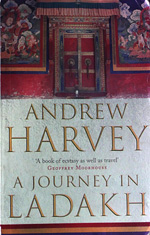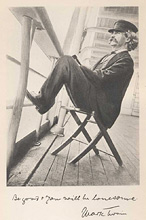
Title: A Journey in Ladakh
Author: Andrew Harvey
Publishers: Mariner Books
Pages: 260
‘A Journey in Ladakh’ is Andrew Harvey’s recollection of experiences from his visit to Ladakh.
Harvey has had a long standing interest in Buddhism, but had never heard of Ladakh. He first comes to know about the ancient Buddhist civilization of Ladakh in a corner of Delhi, where he is urged to make a journey to the remarkable mountain kingdom. When he listens to praises of Ladakh again somewhere in a Buddhist retreat in Sri Lanka, he makes up his mind and heads north. The book his full of his encounters with fellow travellers, local people, monks and rinpoches in the mountain country.
The book seems to wander aimlessly during the initial half and is full of random conversations and fragments of his memoirs that fail to form a good story. The author seems to be exaggerating or struggling for words when he describes his own experiences and feelings about the land and its people. The reader begins to feel that the book is no more than a journal of loosely coupled jottings of experiences of a journey in which Harvey describes about the difficulty of travelling in the bus to Leh, about his lodge owner and few talkative fellow tourists. While the book does hint about spiritual inclination of Harvey and the travellers he speaks to, the spiritual quest gains no significance until he meets a head lama.
However, a flow comes back into the book in the later half where Harvey starts getting deeper into the essence of Buddhism as he experiences and tries to understand the core values like love and compassion that form the foundation of every ritual, painting or celebration. He finds it easier than ever to connect with people in his surroundings as he is groomed by conversations with the monks. At times, he witnesses some strange local rituals and even goes through some metaphysical experiences. At the end of his journey, he is barely short of being a convert.
While his spiritual experiences and conversations with the lamas give a good direction to the book, it does feel as though the author has failed to carry his readers along with his experiences. Sometimes it appears as though the author goes through something that can’t be expressed in words, which may also make those experiences appear unreal or his narration limiting. His struggle with narration is evident in some occasions, especially when he describes the landscapes, paintings and some personal experiences in the monasteries. Many distractions in the book that come, such as conversations with his fellow travellers, makes the book slow paced. Yet, for someone interested in Tibetan Buddhism, this is an ideal book to understand the experiences of an outsider’s first brush with the religion.

Author: Mark Twain
Publisher: Available for download from Project Gutenberg
Following the equator is a journal of Mark Twain’s travel across the world on a lecture tour. While we call today as the days of the world travel, Twain was a good hundred years ahead, embarking on such a journey in the last years of 19th century. My own reading of the book is limited to the chapters on India, which runs for nearly 200 pages.
Twain arrives in Mumbai, and travels to many places that include Calcutta, Allahabad, Lucknow, Varanasi and Jaipur. They stand as a tourist’s choice of destination even today. While the book is written more like a personal journal, Twain uses every chance to deviate from his explorations to add stories from history of India, related incidences from his own past, and never misses a chance to pass a sarcastic commentary on everything he observes. A paragraph on the numerous crows that he encounters on the Balcony of the hotel window gives a perspective of Twain’s sarcasm.
They were very sociable when there was anything to eat—oppressively so. With a little encouragement they would come in and light on the table and help me eat my breakfast; and once when I was in the other room and they found themselves alone, they carried off everything they could lift; and they were particular to choose things which they could make no use of after they got them. In India their number is beyond estimate, and their noise is in proportion.
But it is not just humour that touches the reader. He digs deeper into government gazettes and documentary evidences on Thugs – the murderous dacoit clan that once stole from travellers from all over India. His visit to Varanasi includes extensive quotes from credible sources on the ways of Indian pilgrims, but quickly backed up with humorous notes on a suggested itinerary for the pilgrim. He frequently shifts between personal and neutral observations, sarcasm, history and events from his life as the pages progress. Interestingly, despite all the sarcasm that is packed in the book, he is never demeaning the local way of life and the native people, and often comes out as a kind person who sympathized with the subjects of the book.
Because it is written like a diary, occasional digressions may disturb the reader from a smooth flow in many occasions. But the humourous take that he always comes up with, makes up for the digressions. For the Indian reader, ‘Following the Equator’ can be more than a travelogue – it comes with some learnings on the history and gives a perspective of everyday life in India a hundres years ago, besides entertaining thoroughly through the pages.

Information. ‘Ganges’ is a DVD of three episode TV series aired on BBC in 2007. It is distributed in India as DVD by Saregama. The video is approximately 150 minutes long. As of posting this, it retails for Rs.399.00 in India.
Review. The series takes the viewer along the river Ganges, tracing the river from its birth to the place where it discharges into the sea. The first part, called ‘Daughter of the Mountains’, is about the river originating from glacial melts and swiftly moving down the Himalayas to reach the plains in Haridwar. The second part – River of Life – is about the river, religions and the way of life of people in the Gangetic Plains, till it reaches the delta. Predictably, the third part is dedicated to the river delta and the Sundarbans, and is called ‘Waterland’.
The excellent quality of photography grips the viewer throughout the series. It is all the more evident in the first part where the Ganga flows through magnificent mountain ranges. Other best appeal of the DVD is in the portrayal of the wildlife, which begins with lamergiers and griffons in the Himalayas, and then takes us through the aquatic life in the plains and the wildlife of the delta region. For the Indian audience, the parts of the DVD covering the culture, and stories related to birth of the Ganges and evolution of culture seems like nothing new. Despite that, the narration remains excellent through the series. At the end of the three episode, it is the quality of photography that remains vivid in memory. Watch it on HD screen to do justice to the video.


